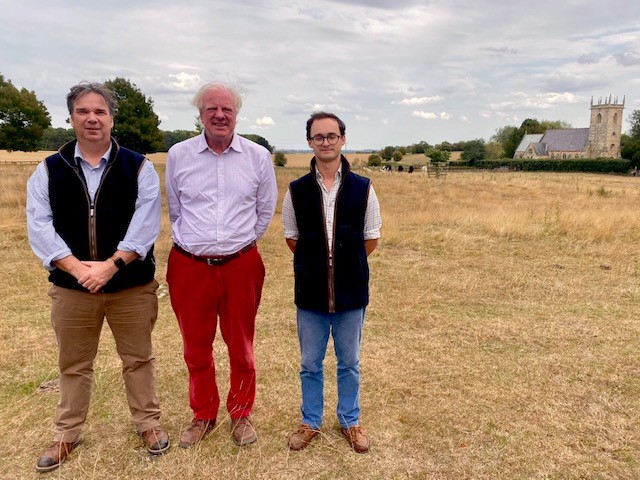The 7,000 Acres Group, a collection of residents from villages between Lincoln and Gainsborough, are campaigning to raise awareness of solar farm proposals in the area, highlighting issues associated with their development:
There are plans to develop over 7,000 acres of land in the area between Lincoln and Gainsborough, on productive farmland. Three industrial-sized solar farms are currently in formal planning.
The two companies involved, Island Green Power and Low Carbon, are proposing to build these projects and once finished, they will each be larger than the largest solar farm development in Europe.
A fourth solar farm is also being proposed by Tillbridge Solar, pushing to total land area to be used towards 10,000 acres mark. These developments will impact over 30 villages in the area.
The reason that these proposals are so large lies, in part, with the fact that solar power has such a low power density – i.e. it takes a huge amount of space to produce energy, which makes it a very inefficient use of land, particularly where there are important competing demands for its use, such as agriculture.
In addition, it may seem obvious, but solar gain in the UK is relatively low; this is the amount of energy that can be captured from the sun. Solar at this scale is being developed in India, China, Egypt and the United Arab Emirates – places which have over double the solar gain, so each panel will produce twice the electricity of a panel in Lincolnshire.
Despite the headline “power ratings” of 500MW to 600MW for these solar schemes, in the UK the average output from solar is around 11% of these figures (according to UK Government statistics), so the 4 proposed schemes potentially have a total headline power output of around 2000MW, but they would only provide 220MW over a year. For comparison, that is less than half one of the 8 generating units at the closing Cottam and West Burton Power Station sites, where the proposed schemes would connect to the National Grid – yet the solar schemes would use around 20 times the land of the old power stations.
Solar power generation provides a sharp peak of output when the sun is at its strongest, in the summer, in the middle of the day, when there is no cloud cover. Without means of storing excess energy in summer for use in winter evenings, the schemes will contribute little to Britain’s energy mix – and nothing when the country is most hungry for power, despite the vast amount of land they will consume.
These developments are being designated as Nationally Significant Infrastructure Projects, bypassing local planning laws and taking the planning decision out of the hands of local government, who are best placed to see the impact on local communities.
The 7,000 Acres Group is a collection of residents from more than 30 villages in the area that have come together to raise awareness of the scale of these projects and to put forward the argument that the proposed developments are totally unsuitable for the area, as well as for the country’s needs.
The Group are not against renewable energy projects, as they are well aware that energy security and reduction in carbon emissions are key to a sustainable planet. The Group are concerned that the proposed developments are taking up valuable farmland (Grade 3b and above), reducing our ability to provide food security for thousands of people.
There is also the consideration that the production and transportation of the solar panels and equipment will create a substantial carbon footprint before these projects are built. Covering our countryside with vast quantities of plastic, glass, metal and batteries is not “Levelling up the Nation.”
The Group agrees with the UK Government, that a much more suitable approach to developments of this nature is that they are built on brownfield sites – in line with current guidelines.
The Group does not understand why, in the name of the environment, thousands of acres of countryside could be covered with solar panels, when only around 3% of the UK’s households have solar panels fitted. Planning must change – to promote the installation on domestic and commercial rooftops, as a priority. There are a number of residential housing developments being built in the Gainsborough area, not one has made provision for solar panels to be installed on the roofs of these ‘new-build’ properties.
Whilst the construction of these solar farms will require a considerable labour, the ongoing operation of these developments requires very little human interaction. Long-term job creation for these schemes is minimal, with many local farm workers at risk of losing their jobs as the farmland is taken over. The local community will receive very little in terms of community gain, in contrast to the hundreds of millions of pounds going into the pockets of investors.
The 7,000 Acres Group will be campaigning to build up local awareness of these solar farm proposals and highlight the issues associated with their development.
The Group also notes the actions of the ‘No Solar Desert’ campaign in raising the issues to the local community, and we welcome the recent announcement that a 616 acre development by Island Green Power for West Burton 4 site near Retford has been withdrawn.
The basis of the withdrawal seems to be that the original assessment of land quality for agricultural designation was flawed and deemed to be wholly wrong. We believe this shows that we should challenge the assumptions and processes employed by the developers in selecting the remaining proposed sites, as those too may be flawed. The 7000 Acres Group continues to oppose the remaining proposals affecting around 30 villages between Gainsborough and Lincoln.



